Native Shrubs for the Home Garden
Posted in Gardening Tips on May 7 2013, by Sonia Uyterhoeven
Sonia Uyterhoeven is the NYBG‘s Gardener for Public Education.
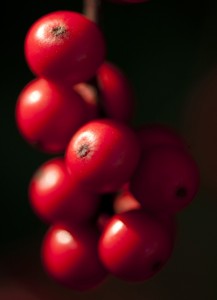
Our newest garden, the Native Plant Garden is a 3.5-acre notebook of ideas for your home garden. Native shrubs—like the ones you will see here—are an asset to any landscape, as many of them are durable plants which serve as homes and food for native bird species. Native shrubs often have beautiful spring or summer flowers and colorful fall foliage.
Deciduous winterberry hollies, Ilex verticillata, a standard in the nursery trade, are indigenous from Nova Scotia through Florida and west to Missouri. In their native habitat they prefer moist soils and swampy areas where they tend to sucker. However they will still grow prodigiously in average garden soil, but with a more upright form that can tolerate full sun and light shade.
These hollies are dioecious meaning there are male and female flowers on separate plants. The females are covered with berries later in the season. The male, meanwhile, can be tucked back in a corner. The bright-colored berries, technically drupes, are often red, but can vary from scarlet to orange-yellow, and are eaten later in the winter by over-wintering birds. They are too hard for migratory species which mean they hang on into the winter when they can nourish the birds toughing out the winter, hence the name “winterberry.”
Reading into the meaning of a cultivar’s name will help you determine the males from the females in I. verticillata. Berry Heavy®, ‘Red Sprite’, and ‘Winter Red’ are female, while ‘Jim Dandy’ and ‘Southern Gentleman’ are clear about their gender. ‘Red Sprite’ is a compact variety growing to an average of 3 feet tall; ‘Winter Gold’ and ‘Maryland Beauty’ reach between 5-7 feet; and ‘Winter Red’, Berry Nice®, and Berry Heavy® reach up to 9 feet tall with a fantastic fruit set. Use ‘Southern Gentleman’ as the pollinator for ‘Winter Gold and ‘Winter Red’, while ‘Jim Dandy’ will suit the others.
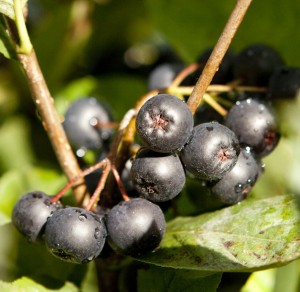
For something different that will still attract birds to your garden, try chokeberries. Black chokeberries, Aronia melanocarpa, grow well in full sun to part shade and tolerate wet to dry soils. A cultivar like ‘Viking’ can reach up to 6 feet tall. Fall foliage is often a vivid combination of yellow, red, and purple, with good-sized black fruits covering the shrubs.
Red chokeberry, Aronia arbutifolia, is a slightly larger shrub at 6-8 feet tall, with spectacular raspberry red to purple fall foliage. ‘Brilliantissima’ is named not only for its fall foliage, but also for the abundance of large red pomes that cover the shrub late in the season.
If the name wasn’t enough of a hint, chokeberries will make your mouth pucker. However, they are edible when frozen or cooked with sugar and made into syrups, chutneys, and jams. Even the birds will wait until the cold softens the berries’ bite before they feed on them.
If you would like to create a wildlife-friendly hedge, consider bayberries or blueberries. Northern bayberry, Morella [Myrica] pensylvanica, can grow in just about any soil type, ranging from sand dune and dry forest border to the margins of a swamp. It prefers full sun, but will grow happily in light shade, with size ranging from 2-6 feet depending on site conditions. In a coastal area, it will grow 2-3 feet tall, while the average garden will support a plant at up to 6 feet or taller.
Bayberry is a semi-evergreen shrub that will hold its foliage well through fall, with leathery leaves that turn papery brown and persist into winter. It also produces waxy berries in the fall that are edible to birds and used to make bayberry candles.
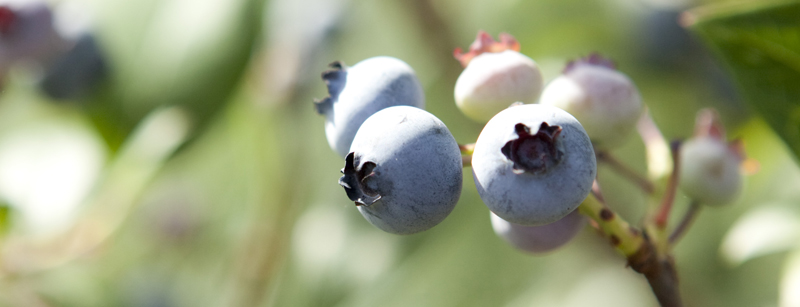
Highbush blueberry, Vaccinium corymbosum, is another underused native that makes a wonderful hedge or specimen plant. Just remember to plant more than one if you’d like to feed both the birds and your family. Fruit begin to form in early summer and into the fall, with early, mid, and late varieties to choose from.
In the Native Plant Garden, you’ll find ‘Duke’ and ‘Elliot’ varieties forming the hedge along the garden border. ‘Duke’ is an early-fruiting variety that grows 4-6 feet tall, a heavy producer with orange-yellow fall foliage. ‘Elliot’ is a late variety that produces blueberries into September, with spectacular bright red-orange fall foliage close behind.
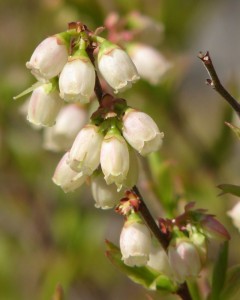
In our wetland area, we have planted lowbush blueberry, Vaccinium angustifolium, and Vaccinium ‘Chippewa’, a cross between a highbush and lowbush blueberry. ‘Chippewa’s compact growth, 3-4 feet, is well-suited for container gardening or small urban spaces. These smaller hybrids tend not to be as prolific as the highbush, but ‘Chippewa’ will produce large berries in mid-summer with red fall color following. Lowbush blueberries and hybrids do well in wet to moderately dry soils with good drainage.
For a hedge, plant blueberries 2-2 1/2 feet apart; 5-6 feet apart for specimens. They like acidic soil, and in the northeast the pH is generally low enough to suit these Ericaceous shrubs. Mulching with a composted bark mix (generally pine) is a great way to maintain good moisture levels and keep the pH low.
The key to success with native blueberries is pruning the shrubs annually to create vigorous plants with better fruiting. Prune in late winter to early spring, removing low growth around the base of the plant as well as dead or discolored branches. Then select and remove some of the older branches; removing 1/3 of the wood each year will produce a better crop.
Other native shrubs worthy of note include the dwarf fothergilla, Fothergilla gardenii and Fothergilla major ‘Mt. Airy’ which provide a fragrant early spring bloom and fiery yellow to red fall foliage. Later in the summer, sweetshrub, Calycanthus floridus, and summersweet, Clethra alnifolia bloom with stunning fragrances. For a show in the winter months, the red osier dogwoods, Cornus sericea, provide bare stems in a kaleidoscope of reds and yellow-greens; ‘Cardinal’ turns red in winter and morphs into a chartreuse by spring. To maintain good color, cut back 1/4 of the older branches in early spring.
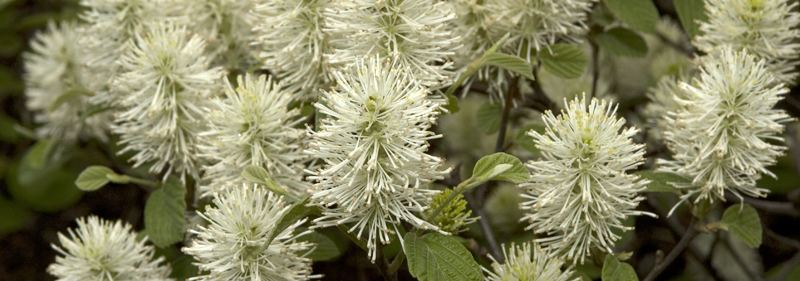
Below is a selection of native shrubs in the Garden:
Shrubs for full sun to partial shade
| Red Chokeberry Aronia arbutifolia ‘Brilliantissima’ | Black Chokeberry Aronia melanocarpa ‘Viking’ |
| Sweetshrub Calycanthus floridus ‘Athens’ | New Jersey Tea Ceanothus americanus |
| Summersweet Clethra alnifolia ‘Hummingbird’ | Red Osier Dogwood Cornus sericea Artic Fire™, ‘Baileyi’, ‘Bergeson Compact’, ‘Bud’s Yellow’, ‘Cardinal’ |
| American hazelnut Corylus americana | Dwarf Fothergilla Fothergilla gardenii |
| Dwarf Fothergilla Fothergilla major ‘Mt. Airy’ | Common Witchhazel Hamamelis virginiana |
| Winterberry Ilex verticillata Berry Heavy®, Berry Nice®, ‘Jim Dandy’, ‘Maryland Beauty’, ‘Red Sprite’, ‘Southern Gentleman’, ‘Winter Gold’, ‘Winter Red’ | Virginia Sweetspire Itea virginica ‘Little Henry™ |
| Sheep Laurel Kalmia angustifolia | Mountain Laurel Kalmia latifolia ‘Freckles’, ‘Peppermint’ |
| Northern Bayberry Morella [Myrica] pensylvanica | Coastal azalea Rhododendron atlanticum |
| Marydel coastal azalea Rhododendron atlanticum ‘Marydel’ | Flame Azalea Rhododendron caledulaceum |
| Pinxterbloom Azale Rhododendron periclymenoides | Plumleaf Azalea Rhododendron prunifolium |
| Smooth Sumac Rhus glabra | American Elderberry Sambucus canadensis |
| Meadowsweet Spirea alba | Lowbush Blueberry Vaccinium angustifolium |
| Highbush Blueberry Vaccinium corymbosum ‘Duke’ & ‘Elliott’ | Blackhaw Viburnum Viburnum prunifolium |
Shrubs for partial sun/shade
| Coastal doghobble Leucothoe axillaris | Spicebush Lindera benzoin |
| Azalea Rhododendron ‘My Mary’ | Catawba Rhododendron Rhododendron ‘Catawbiense Album’ |
| Rosebay Rhododendron maximum | Carolina Rhododendron Rhododendron minus var. minus |
| Silky Stewartia Stewartia malacodendron |


Great article! Very informative. Many homeowners would like to plant bushes and shrubs to attract birds but never seem to know which variety to buy. Thank you for providing a useful chart and valuable information.